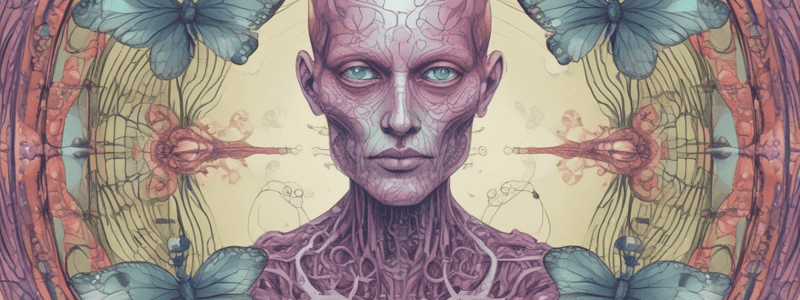Podcast
Questions and Answers
What is the primary function of tumor suppressor genes?
What is the primary function of tumor suppressor genes?
- To stimulate angiogenesis
- To promote cell growth
- To inhibit immune responses
- To repair DNA damage or induce apoptosis (correct)
What is the origin of most oncogenes?
What is the origin of most oncogenes?
- From chromosome integrity genes
- From DNA repair genes
- From mutations in proto-oncogenes (correct)
- From tumor suppressor genes
What is the effect of a single copy of a mutated oncogene?
What is the effect of a single copy of a mutated oncogene?
- It can repair DNA damage
- It contributes to the multistep process of tumor progression (correct)
- It can cause cell death
- It inhibits cell growth
How can retroviruses contribute to tumor formation?
How can retroviruses contribute to tumor formation?
What is a characteristic of tumor cells?
What is a characteristic of tumor cells?
What is a consequence of defective DNA repair?
What is a consequence of defective DNA repair?
What is the result of faulty DNA mismatch repair?
What is the result of faulty DNA mismatch repair?
What is the effect of impaired nucleotide excision repair?
What is the effect of impaired nucleotide excision repair?
What is the role of tumor suppressor genes in cell division?
What is the role of tumor suppressor genes in cell division?
What is the consequence of uncontrolled cell growth?
What is the consequence of uncontrolled cell growth?
Flashcards are hidden until you start studying
Study Notes
Cancer Overview
- Cancer is a prevalent and deadly disease, causing approximately one in four deaths worldwide.
- One in two people is expected to be diagnosed with invasive cancer in their lifetime.
- Cancer arises from a combination of environmental exposures and genetic mutations.
Characteristics of Cancer
- Uncontrolled cell proliferation, culminating in tumor formation (neoplasm).
- Tumorigenesis involves:
- Heightened growth signals
- Resistance to growth-inhibiting cues
- Evasion of apoptosis
- Tumors require a fresh blood supply acquired through angiogenesis.
- Malignant tumors infiltrate nearby tissues and disseminate to distant body sites (metastasize).
Types of Tumors
- Categorized based on their tissue of origin:
- Sarcomas (mesenchymal tissue, such as bone, muscle, or connective tissue)
- Carcinomas (epithelial tissue, such as cells lining the intestine, bronchi, or mammary ducts)
- Hematopoietic and lymphoid malignant neoplasms (leukemia and lymphoma, arising in cells of hematopoietic lineage)
Genetic Alterations in Carcinogenesis
- Genetic alterations of cell regulatory systems are the primary basis of carcinogenesis.
- Cancer can be induced in animal models by damaging specific genes.
- Introduction of normal copies of damaged genes can reverse a cancer phenotype in cell culture systems.
- Most genetic events causing cancer occur in somatic cells.
- Frequency of these events can be altered by exposure to mutagens, linking them to environmental carcinogens.
Causes of Cancer
- Genetic alterations in cell regulatory systems are the primary basis of carcinogenesis.
- Environmental factors interact with genes to contribute to cancer risk.
- Different populations exhibit varying cancer frequencies, suggesting environmental and genetic influences.
- Both genetics and environment contribute to cancer risk, with interactions between the two.
Cancer Genes
- Genetic control of cell growth and differentiation:
- Growth factors
- Specific receptors for growth factors
- Signal transduction molecules
- Nuclear transcription factors
- Mutations can occur in any of the steps involved in regulation of cell growth and differentiation.
The Inherited Cancer Gene Versus the Somatically Altered Gene
- The two-hit theory of carcinogenesis states that a cell can initiate a tumor only when it contains two damaged alleles.
- A person who inherits one copy of a mutant gene must experience a second, somatic mutation in one or more of that gene in order to develop cancer.
Major Classes of Cancer Genes
-
- Tumor Suppressor Genes:
- Inhibit cellular proliferation
- Act as "brakes" on cell division and proliferation
- Help maintain normal function and integrity of cells
-
- Oncogenes (Cancer Genes):
- Most oncogenes originate from proto-oncogenes
- Develop from mutations in any of the four basic regulators of normal cell growth
- A single copy of a mutated oncogene is required to contribute to the multistep process of tumor progression
-
- DNA Repair Genes, Chromosome Integrity, and Tumorigenesis:
- Tumor cells typically have widespread mutations, chromosome breaks, and aneuploidy (genomic instability)
- Genomic instability can occur due to defects in proteins required for accurate cell division or in proteins responsible for DNA repair
Studying That Suits You
Use AI to generate personalized quizzes and flashcards to suit your learning preferences.




